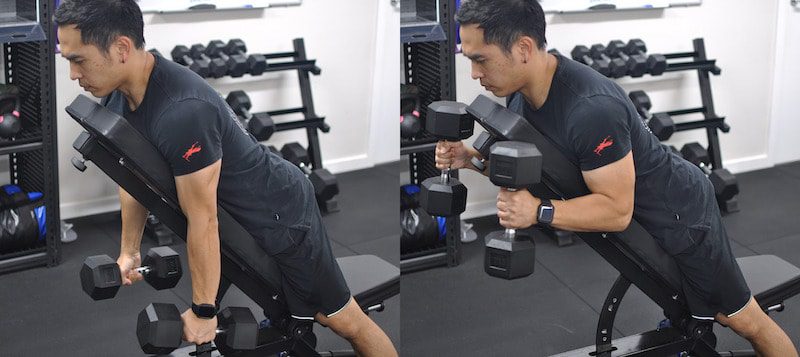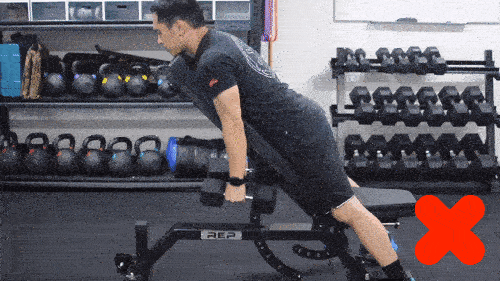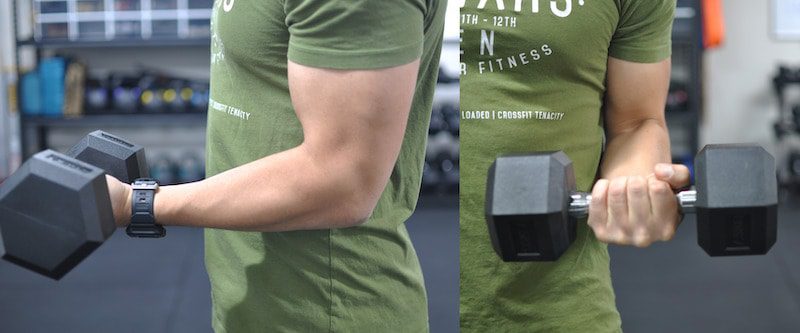
The best online fitness resource you'll ever need. We filter out the BS to ensure you meet your health and fitness goals!

The best online fitness resource you'll ever need. We filter out the BS to ensure you meet your health and fitness goals!

Decline hammer curls are a variation of dumbbell hammer curls where the lifter lies chest down on an incline and the arms are suspended straight down toward the floor at the beginning of the curl.
They are almost identical in every way to spider hammer curls. The only difference between the two is that spider hammer curls can sometimes be performed from the vertical side of a preacher bench.
In comparison to the incline hammer curl, the lifter reclines back, letting the arms fall behind the torso, the arms are in front during a decline hammer curl. Both require a thumbs-up grip.

Where a spider hammer curl can be done standing, leaning against the angled side of a preacher bench, the decline hammer curl requires reclining, facing downward—a very slight difference between the two.
The grip and forward recline define the decline hammer curl.
Decline hammer curls work the brachioradialis, the biceps brachii, and the brachialis in isolation. The brachioradialis is the upper arm muscle that adds thickness and height to the arm above, below, and around the elbow.

All three of these “biceps” muscles must work during decline hammer curls. It’s the orientation of the brachioradialis versus the direction of resistance that favors that single muscle.
The brachialis and biceps also must contribute but decline hammer curls feature the brachioradialis due to the grip orientation. The brachioradialis lies atop the forearm when the thumb is up where it directly opposes gravity.
If you were to turn the palms up, the brachioradialis would rotate to the outside of the arm, and not directly opposite resistance.
In that orientation, the biceps and brachialis would directly oppose gravity and for that reason contribute more overall force to the lift.

You need dumbbells and an incline bench to do decline hammer curls correctly. Adjustable benches work well so that you can set the incline to adjust for your arm length.

Lying forward on a bench makes the strict form easier as it removes the body’s ability to add momentum. Still, there are ways to ruin an otherwise perfectly good decline hammer curl.
Here are some common mistakes to avoid with decline hammer curls:

As with spider hammer curls, this is the most common error and one that’s easy to make if you’re not paying attention to your form. The upper arm should stay at 90° to the ground through the entire set.
Bench set too low so that the weights touch the floor between reps. Dumbbells should be suspended at the ends of your arms at the bottom of a rep.

Not maintaining the neutral, thumbs-up, grip. Your grip shouldn’t roll into palms-up at any point during the lift.
Each rep should be executed smoothly and rhythmically. If you can’t move the weight by moving only the forearm, you’re using too much weight. You’ll be surprised how many benefits you’ll get from less weight and stricter form.
Decline hammer curls’ benefits arise from their ability to isolate the working muscles and prevent the addition of momentum by the trunk, legs, or shoulders.
Gravity forces the arms to hang straight down as the lifter lies chest-down on the bench. That places the direction of resistance in proper orientation: in line with gravity. As the target muscles pull on the weight, they are acting directly against gravity.
The thumbs-up grip places the brachioradialis directly opposing direction of resistance, making this a terrific exercise to work for bulk on the top of the forearm and to add size around the elbow joint.
If hinging (described above) can be avoided, decline hammer curls facilitate a very strict isolation arm exercise. Because the lifter must lie chest down, the legs and upper body can’t be used to swing the weight.
Cheating becomes a lot more difficult. Again, the only cheating that can be done is if the elbows are allowed to drift backward.
You’ll need to use lighter weights than you could otherwise lift to do decline hammer curls correctly. And the thumbs-up grip positions the insertions of the biceps tendon under less tension.
There’s still some tension on the biceps because they are indeed working. They’re just not carrying the percentage of the load they would if a palms-up grip was employed.
There are few if any drawbacks to the decline hammer curl. The only drawback that we can think of would be not having an angled bench-handy.